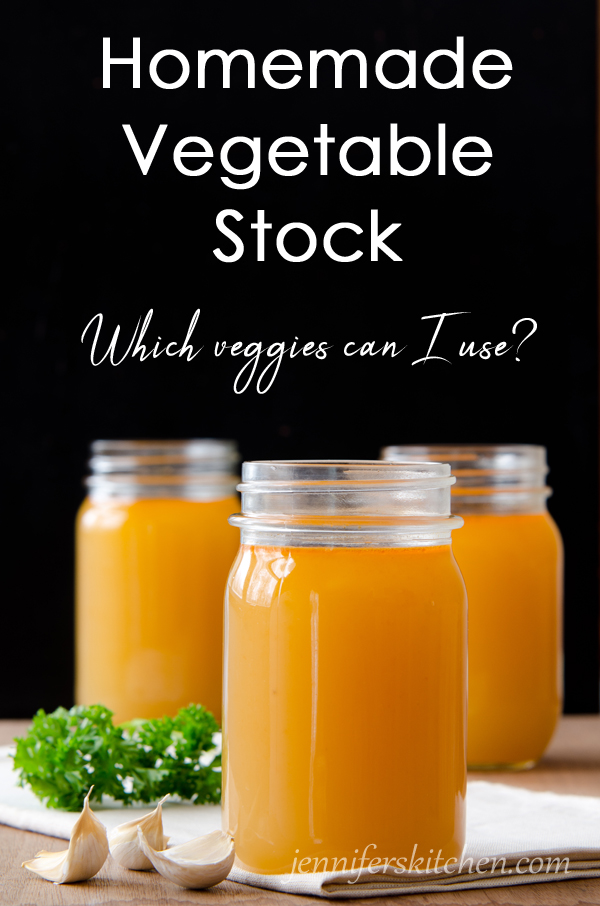A-to-Z List of Vegetables to Include in Vegetable Stock or Broth
If you’re trying to make homemade vegetable stock or broth, it can be helpful to know what goes in stock or broth. What vegetables should you put in stock or broth? And what vegetables should you NOT put in?

Making your own homemade broth or stock is super easy, only takes minutes of your time, and you can control the ingredients!
Choosing Which Vegetables to Include in Stock or Broth
For the best stock or broth, you can’t put in just any vegetable. While some veggies make excellent stock/roth, some vegetables make stock/broth taste bitter. Some will make it starchy or cloudy. Some are simply too strong.
What Vegetables to Put in Stock or Broth
Are you wondering what vegetables make good stock or broth and what ones should be left out? Check out this guide.
Acorn Squash
The peels are great for stock, but the flesh is too starchy and should be left out.
Asparagus
Good in small quantities (no more than 1/6 of the stock ingredients)
Basil
Good in very small quantities (no more than 1/10 of the stock ingredients).
Bay leaves
1 or 2 leaves per quart of liquid is a good amount.
Beet Greens
Good in small quantities (no more than 1/10 of the stock ingredients). You may want to add greens toward end of cooking as they break down quickly.
Beets
Beets can be added, but they will turn the stock a very dark color, which may not work well for some purposes, such as butternut squash soup. Beet skins should not be used.
Bell or sweet peppers
Okay in small quantities (no more than 1/10 of the stock ingredients), but I tend to avoid using peppers as I don’t like the taste they impart.
Bok Choy
Foods in the Brassica family, such as Bok Choy, are too strong for stock/broth and can impart a bitter taste.
Broccoli
Foods in the Brassica family, such as broccoli, are too strong for stock/broth and can impart a bitter taste.
Cabbage
Foods in the Brassica family, such as cabbage, are too strong for stock/broth and can impart a bitter taste.
Carrots
Carrots are one of the best vegetables to put in stock/broth.
Carrot tops (leafy part)
Use only in very small quantities (no more than 1/16 of the stock ingredients). Too many can make the stock bitter.
Celery ribs
This is an excellent vegetable to put in for making stock/broth.
Celery leaves
While the outer leaves can make the stock bitter, a small amount of the inner leaves can be used with good results.
Chard
Good in small quantities (no more than 1/6 of the stock ingredients)
Chives
Good in small quantities (no more than 1/10 of the stock ingredients)
Cilantro
Cilantro is too strong for broth/stock. If you really want to use it, be sure to only use a very small amount. A little goes a long way.
Collard Greens
Foods in the Brassica family, such as collards, are too strong for stock/broth and can impart a bitter taste.
Corn
Corn doesn’t add a lot of flavor and can make the stock/broth cloudy.
Cucumber
Good in small quantities (no more than 1/6 of the stock ingredients)
Dill
Good in very small quantities (no more than 1/10 of the stock ingredients)
Eggplant
Good in small quantities (no more than 1/6 of the stock ingredients)
Garlic
Excellent for making stock/broth.
Green beans
Good in small quantities (no more than 1/5 of the stock ingredients)
Greens
Avoid bitter greens and members of the brassica family (kale, cabbage, Bok Choy). Other greens can be used in small quantities.
Jerusalem artichokes
Good in small quantities (no more than 1/5 of the stock ingredients).
Kohlrabi
Foods in the Brassica family, such as kohlrabi, are too strong for stock/broth and can impart a bitter taste.
Leeks
Leeks are one of the best vegetables for making stock/broth.
Lettuce
Good in small quantities (no more than 1/10 of the stock ingredients). Most lettuce varieties don’t add much flavor to the stock/broth.
Marjoram
Good in very small quantities (no more than 1/10 of the stock ingredients)
Mushrooms
Mushrooms add rich flavor to vegetable stock. (Because I opt for a plant-based diet, I personally don’t eat mushrooms [they are a fungus and not a plant], but if you eat mushrooms, they are a tasty addition to stock.)
Napa Cabbage
Foods in the Brassica family, such as cabbage, are too strong for stock/broth and can impart a bitter taste.
Okra
Okra can add body to broth. Use in small quantities to avoid overwhelming flavor.
Onions
Excellent for making stock/broth.
Onion skins
Onion skins add a lovely color. Just don’t add to many of them unless you want your stock to have a dark color.
Oregano
Good in small quantities (no more than 1/10 of the stock ingredients)
Parsley
Good in small quantities (no more than 1/6 of the stock ingredients)
Parsnips
Good in small quantities (no more than 1/6 of the stock ingredients)
Peas
Good in small quantities (no more than 1/6 of the stock ingredients)
Pea Pods
Good in small quantities (no more than 1/6 of the stock ingredients)
Peppers, Hot Peppers
Not recommended.
Peppers, Bell Peppers
Good in small quantities (no more than 1/10 of the stock ingredients)
Potato peels
Can be used in small quantities. Potato skins add an earthy, but slightly bitter taste. Too many can make the stock cloudy. Be sure the peels are very clean, otherwise you’ll end up with stock that tastes like dirt.
Pumpkin
Pumpkin is a little too starchy for good stock or broth.
Radish
Not recommended.
Romaine Lettuce
Good in small quantities (no more than 1/10 of the stock ingredients)
Rosemary
Some people like the taste rosemary imparts to stock/broth, but some find it lends a bitter flavor, so you may want to use it with caution.
Rutabagas
Foods in the Brassica family, such as Rutabagas, are too strong for stock/broth and can impart a bitter taste.
Scallions
Excellent for making stock/broth.
Shallots
Excellent for making stock/broth.
Spinach
Good in small quantities (no more than 1/6 of the stock ingredients). Best added toward the end of cooking.
Squash
Winter squash is a little too starchy for good stock or broth.
Squash peel
Peels from squash add good flavor to stock or broth. Use no more than 1/8 of the total stock ingredients.
Sweet Potatoes
Sweet Potatoes don’t add much flavor to stock or broth and some variety are too starchy for good stock or broth.
Thyme
Very good in small quantities (no more than 1/10 of the stock ingredients)
Tomatoes
Excellent for making stock/broth. Be sure to avoid including too many tomato seeds as this can give a bitter flavor.
Turnips
Turnips are too strong for stock or broth.
Turnip greens
Ok in small quantities (no more than 1/10 of the stock ingredients). You may want to add greens toward end of cooking as they break down quickly.
Winter squash
Squash is a little too starchy for good stock or broth.
Zucchini
Good in small quantities (no more than 1/6 of the stock ingredients).
Questions? Comments?
Have a question or a comment? Head over to my post about how to make your own homemade broth or stock. That’s where all the action is. 😉

